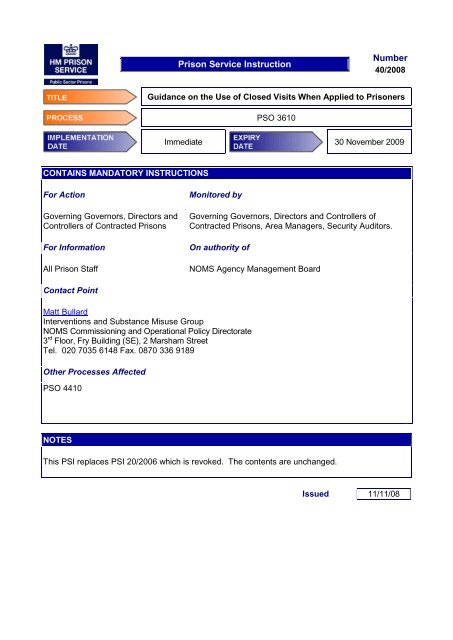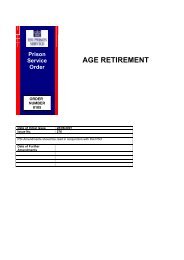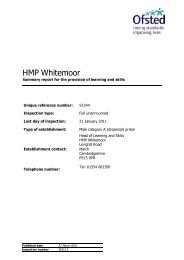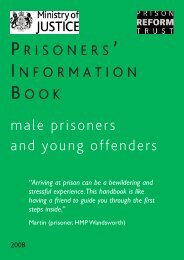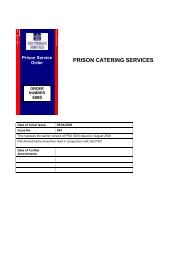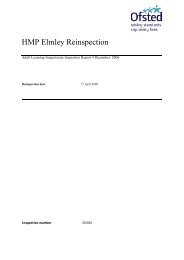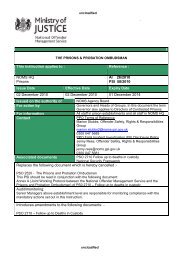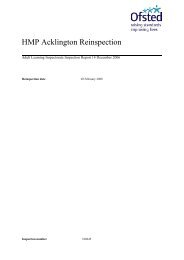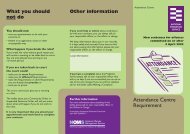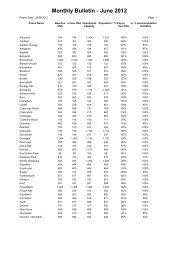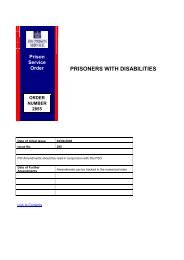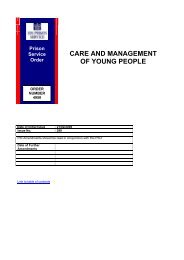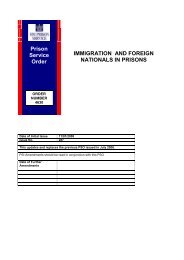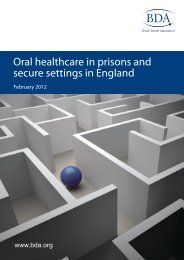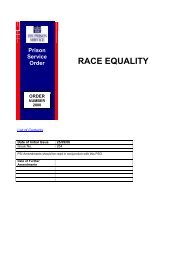Prison Service Instruction Number - Inside Time
Prison Service Instruction Number - Inside Time
Prison Service Instruction Number - Inside Time
You also want an ePaper? Increase the reach of your titles
YUMPU automatically turns print PDFs into web optimized ePapers that Google loves.
<strong>Prison</strong> <strong>Service</strong> <strong>Instruction</strong><strong>Number</strong>40/2008Guidance on the Use of Closed Visits When Applied to <strong>Prison</strong>ersPSO 3610Immediate 30 November 2009CONTAINS MANDATORY INSTRUCTIONSFor ActionGoverning Governors, Directors andControllers of Contracted <strong>Prison</strong>sFor InformationAll <strong>Prison</strong> StaffMonitored byGoverning Governors, Directors and Controllers ofContracted <strong>Prison</strong>s, Area Managers, Security Auditors.On authority ofNOMS Agency Management BoardContact PointMatt BullardInterventions and Substance Misuse GroupNOMS Commissioning and Operational Policy Directorate3 rd Floor, Fry Building (SE), 2 Marsham StreetTel. 020 7035 6148 Fax. 0870 336 9189Other Processes AffectedPSO 4410NOTESThis PSI replaces PSI 20/2006 which is revoked. The contents are unchanged.Issued 11/11/08
PSI 40/2008 Page 1PSI - GUIDANCE ON THE USE OF CLOSED VISITS WHEN APPLIED TO PRISONERSPurpose1. This PSI replaces PSI 20/2006 which has expired. Policy and processes are unchanged.2. The purpose of this PSI is to supplement PSO 3610 and give further information toestablishments to guide decision making in relation to closed visits for prisoners wherethere is a risk drugs may be smuggled through visits. This guidance does not cover theapplication of closed visits to visitors. This PSI must be read in conjunction with PSO 3610.3. Closed visits are a legitimate response to the risk of smuggling contraband goods. Thelegal provision for restricting visiting arrangements for security reasons is in PSO 4410 andin <strong>Prison</strong> Rule 34. PSO 3610 gives further advice on the use of closed visits where it isproved or reasonably suspected that drugs have been smuggled through visits andrecommends a normal period of three months for closed visits to be in place4. Legal challenges to the way in which closed visits have been applied have highlighted theneed for further advice and guidance.5. Establishments must be able to demonstrate that closed visits are applied proportionatelyand kept under regular review. This PSI is intended to guide decision making in relation tothe use of closed visits in response to drugs issues and is intended to supplement theabove documents.Performance Standards6. The <strong>Prison</strong> <strong>Service</strong> Drug Strategy standard requires that prisoners’ communications andvisits must be monitored and controlled to prevent them being used as an avenue forsmuggling drugs. This PSI will assist in managing the use of closed visits as a controlmeasure.Output7. This PSI will:create consistency in practice across the estate;ensure the application of closed visits is proportionate to the risk posed by aprisoner;result in more auditable decision making in relation to closed visits;Impact and Resource Assessment8. None. These processes are already in place.Mandatory Action9. The guidance is intended to guide decision making in relation to closed visits. The bulk ofthe PSI is therefore advisory. However the following elements are mandatory:Closed visits must not be applied as a punishment;In applying closed visits, establishments must consider prisoners on an individualbasis;Closed visits must be applied for a period of time, and not for a specific number ofvisits;Order ref. 3610 Date issued 11/11/ 08
PSI 40/2008 Page 2Audit and monitoringClosed visits must not continue without limit of time;Any additional period of closed visits applied while a prisoner is already on a periodof closed visits, must run concurrently with the remainder of the original period.Imposition of additional periods of closed visits in these circumstances must neverbe consecutive;All prisoners on closed visits must be reviewed every month to assess whether thereis a continuing need for closed visits.10. Individual establishments will be responsible monitoring arrangements for administeringclosed visits. Arrangements outlined in PSO 3610 for monitoring the visits bans initiativewill continue unaltered.Advice and InformationAPPLYING CLOSED VISITS11. Closed visits are an administrative measure, not a punishment. As such, they can beapplied regardless of whether or not a prisoner has been charged at adjudication withsmuggling drugs through a visit.12. Care should be taken to ensure the notification of closed visits is quite separate from anyadjudication procedures.13. Closed visits should be applied where prisoners are proved or reasonably suspected ofinvolvement in drugs smuggling through visits, or are considered to pose a reasonable riskof involvement.14. Establishments should be able to demonstrate that in deciding to apply closed visits theyhave taken into account all the individual circumstances of the case and have actedproportionately. For example, a prisoner simply failing one MDT would not necessarily posethe same risk as a prisoner who was previously known to be involved in drug using activitywho failed an MDT, and a different response may be called for. Equally, a drug dogindication on a prisoner’s cell is likely to warrant an on-suspicion MDT rather than closedvisits. In applying closed visits establishments may wish to look at the following:As balanced against:Patterns of drug use as demonstrated by MDT;Analysis/use of intelligence;Incidents on visits;CCTV evidence or possession of drugs on a post-visit search;Correspondence/telephone monitoring evidence of attempted or actual smugglingthrough visits;Finds from cell searches; andThe prisoner’s index offence and criminal record;Engagement with treatment and support programmes; andInvolvement in a voluntary testing programme. (This should not include anexamination of individual test results.)15. A number of prisons have adopted the practice of applying closed visits following onepositive MDT. This practice is likely to have arisen from papers circulated by ProgrammesGroup in 1996/97 following a pilot study which explored the value of imposing mandatoryclosed visits for prisoners known to use drugs.Order ref. 3610 Date issued 11/11/ 08
PSI 40/2008 Page 316. A single positive MDT should not necessarily be taken to provide sufficient evidence ofsmuggling or of a risk of the prisoner being persuaded to smuggle. Given the need forproportionality, where failed MDTs are the only factor, closed visits should normally beimposed only after repeated (two-three) MDT failures, rather than after just one failed MDT.17. In considering MDT failure, establishments may wish to consider that certain drug positives(for example opiates) may indicate a greater potential risk of a prisoner being likely tosmuggle drugs through visits than others (for example cannabis).LENGTH OF CLOSED VISITS PERIODS FOR PRISONERS18. Common practice has been for closed visiting conditions to be applied to a specific numberof visits or to a prisoner’s visits entitlement for a particular number of months; PSO 3610recommends closed visits are applied to prisoners for three months entitlement of visits(paragraph 21). It is now clear from discussions with legal advisors that we need to link therisk of smuggling posed by a prisoner primarily with a period of time and not with a numberof visits.19. The rationale behind this is that with the passage of time risk factors such as drug takinghabits, trends of drug use in the prison and pressure to smuggle drugs can alter. The actualrisk will increase with increased frequency of visiting. However, given that the frequencywith which prisoners take visits varies, it is not logical to assume prisoners remain at risk fora specific number of visits.20. If a prisoner is prescribed a set number of closed visits and refuses to take visits in closedconditions, he would effectively remain on closed visits indefinitely. Equally, if a prisoner’svisits are infrequent, closed visits may continue for a disproportionate length of time. Itcannot be considered to be proportionate to risk for a prisoner to remain on closed visitswithout limit of time. If a prisoner refuses to take visits, the same objective has beenachieved, no contraband goods enter the prison in that time period.21. Closed visits should, therefore, be applied for a specific period of time for which a prisoneris considered to be at risk, and not for a specific period’s entitlement or a set number ofvisits. Some prisoners may choose to take no visits or fewer visits whilst under closedvisiting conditions. Their statutory visits order entitlement should not be affected.APPLICATION OF FURTHER CLOSED VISITS, WHILST A PRISONER IS ALREADY ON ACLOSED VISITS REGIME22. If a prisoner is already on a period of closed visits, and a further incident occurs indicatingthey still pose a risk of smuggling drugs (and are likely to when those closed visits end), theprison may wish to impose further closed visits. This is acceptable, given that the prisonerposes a renewed risk.23. The prisoner must not, however, be expected to complete the initial period of closed visitsbefore starting the second period. If a prisoner is placed on 3 months closed visits inJanuary, and in February there is a renewed risk and a further three month closed visits areimposed, this second closed visits period should commence immediately and runconcurrent with the remaining period of the first. The prisoner would end his closed visitssometime in May, not in July.24. If the prisoner was required to serve closed visit periods consecutively, there would be astrong likelihood that the period for which they remained on closed visits would bear littlerelation to the actual risk they posed. This would not be a proportionate response to risk.Order ref. 3610 Date issued 11/11/ 08
PSI 40/2008 Page 4REVIEWING CLOSED VISITING ARRANGEMENTS25. The decision to place a prisoner on closed visits should not be the end of the process.<strong>Prison</strong>s must be alive to the possibility that circumstances can alter, rendering the closedvisits no longer necessary or proportionate. Examples may include:<strong>Prison</strong>er completes a treatment programme and there are clear indications that theyno longer pose a risk; or<strong>Prison</strong>er has had negative MDTs and there are no indications of drug abuse or drugdealing activity.26. All prisoners on closed visits must be reviewed every month to assess whether there is acontinuing need for closed visits. The level of risk must be reassessed using criteria suchas those mentioned in paragraph 13. If during the original prescribed period of closed visits(normally 3 months) there is further evidence that the prisoner is still at risk, an additionalperiod of closed visits may be applied in line with paragraph 22-24 above. Such closedvisits must continue to be subject to a monthly reassessment of risk.27. A summary of guidance is at Annex A.Contact Point28. Any enquiries on this guidance should be directed to:Matt BullardInterventions & Substance Misuse GroupNOMS Commissioning and Operational Policy Directorate3 rd Floor, Fry Building (SE), 2 Marsham StreetTel: 0207 035 6148Fax: 0870 336 9189(signed)Ian PoreeDirector of Commissioning and Operational PolicyOrder ref. 3610 Date issued 11/11/ 08
PSI 40/2008 Page 5ANNEX AGUIDANCE ON THE USE OF CLOSED VISITS WHEN APPLIED TO PRISONERSSUMMARYClosed visits are not a punishment.Closed visits may be used as an administrative measure where there is anidentified risk of smuggling drugs through visits (PSO 4410, PSO 3610).Factors for consideration include:- patterns of drug use as demonstrated by MDT;- analysis/use of intelligence;- CCTV evidence or possession of drugs on a post-visit search;- correspondence/telephone monitoring evidence of attempted or actualsmuggling through visits;- finds from cell searches;- the prisoner’s index offence and criminal record;- engagement with treatment and support programmes; and- involvement in a voluntary testing programme (but not individual test results).<strong>Prison</strong>ers must be considered on an individual basis.Closed visits may, in the first instance, be imposed for up to three monthsduration. Closed visits must not be based on a prisoner’s visits entitlement fora particular period, nor continue indefinitely until a specific number of visitshave been forfeited.If during the period of closed visits there is a further indication of a risk ofsmuggling, for example, new intelligence, an additional period of closed visitsmay be imposed. This additional period must run concurrently with theremainder of the original period. Imposition of additional periods of closedvisits in these circumstances must never be consecutive.<strong>Prison</strong>ers must be assessed on a monthly basis to see if they pose acontinued risk of smuggling. If not, the period of closed visits must bediscontinued.If a prisoner refuses to take any visits under closed conditions those visitsmust not be forfeited when the period of closed visits ends.Order ref. 3610 Date issued 11/11/2008


